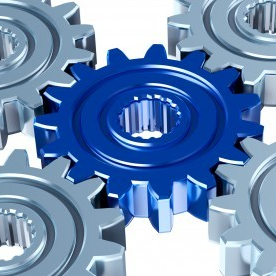
Why 1970s Database Technology Is Still Relevant Today
Max Schireson, chief executive of NoSQL database vendor MongoDB, started a heated conversation two weeks ago when he said that relational database technologies are on their way out because they’re too old and ill-suited to handle today’s big data processing needs. Not surprisingly, those comments rubbed members of the NewSQL database community the wrong way.
 Schireson was interviewed by ZDNet for a story on the demise of the relational database. In the piece, he makes a number of points about the challenges faced by developers of traditional relational database technologies, including the large number of users that a database needs to serve, as well as the types of data that needs to be stored inside of it. NoSQL databases such as MongoDB have grown in popularity for their ability to function without a strict database schema and their ability to automatically shard data horizontally across nodes.
Schireson was interviewed by ZDNet for a story on the demise of the relational database. In the piece, he makes a number of points about the challenges faced by developers of traditional relational database technologies, including the large number of users that a database needs to serve, as well as the types of data that needs to be stored inside of it. NoSQL databases such as MongoDB have grown in popularity for their ability to function without a strict database schema and their ability to automatically shard data horizontally across nodes.
“The database market is in need of a big change,” Schireson said the story, titled “MongoDB chief: Why the clock’s ticking for relational databases.” “The technology that people typically use, the database layer, was designed in 1970 with a very different set of requirements in mind.”
While there are many who agree with Schireson, his comments drew the ire of his competitors, notably members of the NewSQL database community. “It’s a little unhinged from the reality of both today and where things are going,” says Robin Purohit, CEO of relational database vendor Clustrix.
“You’re never going to run a transactional e-commerce engine, even one that reaches hyperscale, on a NoSQL database,” Purohit tells Datanami. “These things need certain properties, ACID properties, trusted transactions. They really need SQL to connect to dots of customer interaction.”
 |
|
| MongoDB CEO Max Schireson | |
The combination of relational technology and SQL may seem “too 70s” to some. But nobody would accuse Facebook of using retro Codd-ish technology just to earn style points with its customers. Facebook, of course, made news last year when it re-introduced relational and SQL technology back into its mammoth IT operation, in particular for analytics.
Purohit chuckles when he talks about how many of the big data vendors–from NoSQL database vendors to proprietors of Hadoop–are scrambling this year to get SQL interfaces into their products.
“If you look at where the Hadoop crew is going and even where Mongo is going, their programing interfaces are becoming more SQL-like,” he says. “That’s the big buzz this year. To get more of the data that’s sitting in these new databases, even the new unstructured ones, you’ve got to use more of a structured query language that can do more complex operations without thousands of lines of application code. So if anything we’re seeing that there’s more of the good stuff of the relational model that’s being put back into these open source databases as the market moves more to maturity and enterprise adoption.”
The big data revolution has had a rising tide effect on nearly the entire database industry. The early innovators in distributed database technologies, such as MongoDB, Couchbase, and Datastax, have been rewarded with lots of venture funding and fast growth. As the NoSQL business matures, we’re now seeing scale-out NewSQL relational databases, such as Clustrix, VoltDB, and NuoDB, start to garner interest. While all this is happening, the “legacy” relational database vendors, Oracle, Microsoft, and IBM, don’t appear to be starving.
As the big data hype begins to wear off, users will realize that there’s no one-size-fits-all database out there, and that each type of database has a role to play. If you’re looking to deploy an ERP system from SAP, Oracle, or Infor, chances are good you’re not going to pick a NoSQL or a NewSQL database to do this, because ERP systems have evolved over decades to run on Oracle, DB2, SQL Server, and (to a lesser extent) MySQL. If you’re building a massively scalable Web application, you could try and stretch MySQL to handle it, but you would probably be better off using a NoSQL or a NewSQL database, which are good at different things.
 |
|
| Clustrix CEO Robin Purohit | |
In Purohit’s view, document-store NoSQL databases like Mongo are very good at serving data to fill Web pages, while NewSQL databases like excel at processing transactions and providing real-time analytics on relatively small data sets. “Almost all of our customers in ecommerce, our best segment, use Mongo side by side with our product,” he says. “They use Mongo for things like product catalogs, to display product information and pictures on the Web, and they use Clustrix for real-time transactional and analytic engines. There are different tools for the job.”
The CEO of Mongo’s closest competitor, Couchbase, said as much during a recent Datanami interview. “NoSQL database make very different tradeoffs than a relational database and we think the tradeoffs fit much better with the Internet and mobile apps of today,” said Bob Wiederhold. “So when you ask ‘Is durability important?’ it’s hard to answer no. Durability absolutely is important. But there are certain types of data where you’re willing to give up a measure of durability in order to get much higher performance and NoSQL databases, for example, allow you to make that decision and make that tradeoff.”
Purohit has talked with Schireson many times and it doesn’t appear there’s any ill will between them. But there’s a load of competitiveness involved, and MongoDB’s success with venture capital funding has perhaps exacerbated the situation. “He’s the CEO of a $1.2 billion company so he has to be articulating a bigger grand vision versus a legacy $30 billion market. That’s what’s going to get his investors excited and attract future ones,” the NewSQL CEO says. “That’s his role as startup CEO who has a big valuation, but it’s just a reality check that customer are starting to realize how all these pieces are falling into place.”
Related Items:
Picking the Right Tool for Your Big Data Job
Look Out, Mongo, Here Comes Couchbase
RDBMs: The Hot New Technology of 2014?






























